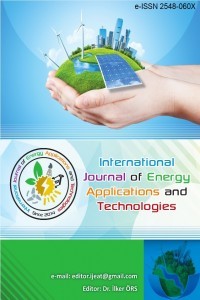Development of a household anaerobic digester for rural areas in Sudan
Development of a household anaerobic digester for rural areas in Sudan
anaerobic digestion, biogas, household, rural areas, Sudan,
___
- [1] Rajendran, K., Aslandzadeh, S. and Taherzadeh, M. J. (2012). Household biogas digesters – A Review, Energies; 5(8), 2911-2942; doi:10.3390/en5082911
- [2] Jun Hou, Weifeng Zhang, Pei Wang, Zhengxia Dou, Liwei Gao and David Styles (2017). Greenhouse Gas Mitigation of Rural Household Biogas Systems in China: A Life Cycle Assessment. Energies; 10, 239; doi:10.3390/en10020239
- [3] Sander Bruun a,n , Lars Stoumann Jensen a , Van Thi Khanh Vu b , Sven Sommer (2014). Small-scale household biogas digesters: An option for global warming mitigation or a potential climate bomb? Renewable and Sustainable. Energy Reviews; 33: 736–741
- [4] Shaoqing Chen, Bin Chen, Dan Song (2012). Life-cycle energy production and emissions mitigation by comprehensive biogas–digestate utilization. Bioresource Technology; 114: 357–364.
- [5] Shikun Cheng, Zifu Li, Heinz-Peter Mang, Elisabeth-Maria Huba, Ruiling Gao, Xuemei Wang (2014). Development and application of prefabricated biogas digesters in developing countries. Renewable and Sustainable, Energy Reviews; 34 :387–400.
- [6] Thien Thu CT, Cuong PH, Hang LT, Chao NV, Anh LX, Trach NX, Sven G. Somme (2012). Management practices on biogas and non-biogas pig farms in developing countries – using livestock farms in Vietnam as an example. Journal of Cleaner Product; 27:64–71.
- [7] Thanh Ba Ho , Timothy Kilgour Roberts and Steven Lucas (2015). Small-Scale Household Biogas Digesters as a Viable Option for Energy Recovery and Global Warming Mitigation—Vietnam Case Study. Journal of Agricultural Science and Technology A 5:387-395 doi: 10.17265/2161-6256/2015.06.002.
- Yayın Aralığı: Yılda 2 Sayı
- Başlangıç: 2014
- Yayıncı: İlker ÖRS
LAITH JAAFER AL-SAADY, Fouad A. Saleh, Bassim M. Maajel
Impact of Vehicle Hybridization on Fuel Consumption Economy
Development of a household anaerobic digester for rural areas in Sudan
Hazir FAROUK, Mutaz ELOBAİD, Omer ABDELAZİM, Mohammed SALAH, Khalid BAKHEET, Andrew Lang
THE EFFECTS OF INCENTIVES ON RENEWABLE ENERGY RESOURCES FOR HOME USERS
FATİH BULUT, Murat LÜY, Ertugrul ÇAM
Measurement of Energy Consumption of WSN for Indoor Environment
